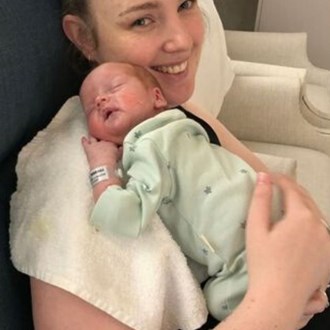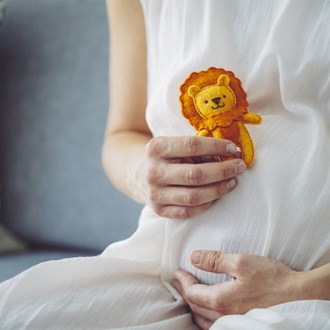Perineal stretching: vaginal stretching for childbirth

You can prepare your vagina for childbirth with these massage and stretching techniques
By Frances Sheen
February 22 2019
What is perineal stretching (or vaginal stretching) for childbirth?
Your perineum is the area between your vaginal opening and the anus. Perineal massage or perineal stretching during late pregnancy can increase elasticity in that area and reduce the risk of 'tearing' during childbirth, as the baby's head comes out. It can also help with pain during the crowning stage during a vaginal delivery. It isn't recommended before you are 34 weeks pregnant.
What are the benefits of vaginal stretching for childbirth?
Studies have found evidence that regular perineal massage towards the very end of your pregnancy - after week 34 - can reduce the risk of tearing. Vaginal tearing (or perineal lacerations) occur during childbirth, when the baby's head crowns and comes out of the vaginal opening and is either too large for the vagina to stretch around or the head is a normal size but the vagina doesn't stretch easily.
These kinds of tears are relatively common, and because it's only the skin around the vagina, they typically heal on their own in the weeks following the birth.
Some tears are more extensive and require treatment. Your midwife or obstetrician will carefully examine you after delivery to identify and repair any injuries.
In a bid to prevent any tearing, doctors recommend that women try perineal stretching and massage. It's often be found to work best on first-time mothers.
As a result benefits include increasing the stretchiness of the perineum and improving the blood flow to this area which enables it to stretch more easily and less painfully during the birth of your baby.
Tears in the perineum are less likely and you might not need an episiotomy. An episiotomy is sometimes known as a perineotomy, and is a a surgical cut made on the perineum during childbirth, to aid a difficult delivery and prevent a tear or split of the skin.

Getty Images
What are the risks of perineal massage or stretching?
Do not perform perineal massage in the following situations:
- before Week 34 of pregnancy
- if you have placenta praevia (a low–lying placenta) or any other condition where there is bleeding from the vagina during the second half of pregnancy.
- if you are suffering from vaginal herpes, thrush or any other vaginal infection, as massage could spread the infection and worsen the condition.
- if you or your partner has an open wound or infection on the hands or fingers.
Is perineal massage scientifically proven?
Back in 2006, there were four scientific studies on perineal massage. These trials enrolled 2,497 pregnant women. Three of them involved women without a previous vaginal birth.
Th overall finding was that women who did a perineal massage had a 10% decrease in the risk of tears that required stitches (also called “perineal trauma”), and a 16% decrease in the risk of episiotomy—but these findings were only true for first-time mothers.
For second-time mothers who had already had a vaginal birth, pre-natal perineal massage did not reduce the risk of perineal trauma (any tearing requiring stitches).
How to do a perineal massage?
As you get more pregnant, sometimes it can be hard to locate your perineum because of your bump! As a result it can be a good idea to ask your partner to do it instead. Try to do this at least once a week.
1. Before beginning perineal massage, wash your hands and trim your nails.
2. Find a comfortable position that allows you to reach your perineum, either by reaching your hands in front of you or behind you. For example: a) Sitting propped up in bed with your knees bent b) squatting against a wall for support with or without the aid of a stack of books or stool; and c) raising one leg such as in the shower or on the toilet. Feel free to use different positions on different days or even change positions during your massage if you become uncomfortable or tired.
If your partner is doing it for you, any of these positions are fine too.
3. Pour about a teaspoonful of massage gel onto your fingers and apply it to the perineum, taking care to ensure that your thumbs or fingers are also well-lubricated. Natural massage oil is best like vitamin e oil or coconut oil or a water-based lubricant like KY Jelly works well. (Don't use any petroleum-based products for perineal massage. You can also choose a massage gel that is specifically designed for regular perineal massage.
1. Insert your one or two thumbs about an inch into your vagina up to about your knuckle. Gently, but firmly, apply pressure downwards towards your anus. At the same time, pull your thumb out very slightly so you feel like your perineum is being stretched. Keep applying pressure until you feel a slight tingling sensation, this is your perineum being gently stretched. This should not hurt. Allow the perineum to stretch for a minute or two. You might feel slight burning or stretching , but if you experience pain, stop the perineum massage.

2. Once the perineum has been stretched for two minutes or so, gently move your thumb up along the sides of the vagina, stretching it from side to side. This will be what happens when the baby's head crowns. Be gentle and if there's any pain or there is a stinging sensation stop immediately.
3. Be gentle - a vigorous touch could cause bruising or swelling. During the massage, avoid pressure on the urethra (urinary opening) as this can lead to irritation or infection.
4. In all, the whole massage should take about ten minutes to do.
What can you buy to help stretch the perineum?
You might have heard about a device called the Epi-No, which claims to prepare your perineum for delivery and reduce the risk of tears and trauma to your pelvic floor region.
Opinion is divided about whether or not it's successful in its claims but here are the facts.
1. The Epi-No was invented by a German doctor in the early 1990s who looked at ways he could prepare the vagina for birth.
2. Basically the Epi-No is an inflatable balloon, attached to a hand-operated pump with a pressure display – similar to a blood pressure pump.

Epi-No
3. The Epi-No is a vaginal stretching device designed to be used from 36 weeks pregnant.
4. You insert the balloon into the vagina, and inflate it with the hand pump until you feel some pressure, but not pain.
5. After your pelvic floor muscles have contracted to allow for the balloon to fill with air, relax them to expel the inflated balloon gently. This simulates the action of the muscles during birth. Women generally use the device once or twice daily, for around 15 minutes each time. You can gradually increase the size of the balloon, so the perineal area becomes used to being contracted and released, like when your baby's head starts to crown.
TOP THREE QUESTIONS ON PERINEAL MASSAGE
1. How big can a vagina stretch?
Every woman's body is different, but our vaginas are built to give birth to children and adapt accordingly. While some women are cut to ease the baby’s head out other women find that their vagina stretches so the baby's head can fit through without too much trauma.
2. Will my vagina stretch after the birth and then never go back to its old size?
“The vagina can feel looser, softer and more ‘open’,” leading consultant in urogynaecology Dr Sohier Elneil told Her. “It may also look and feel bruised or swollen. This is normal, and the swelling and openness should start to reduce a few days after your baby is born.













